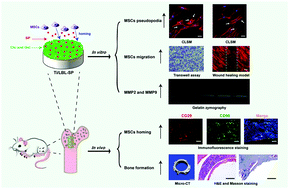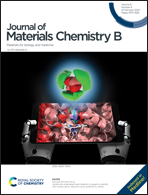Substance P-embedded multilayer on titanium substrates promotes local osseointegration via MSC recruitment†
Abstract
In this study, the chemokine substance P (SP) was inserted into multilayered systems on titanium (Ti)-based substrates for endogenous mesenchymal stem cell (MSC) recruitment to facilitate bone healing. The multilayer was constructed with cationic chitosan (Chi), SP and anionic gelatin (Gel) via a spin-coater-assisted layer-by-layer (LBL) approach. The characterization results demonstrated that the multilayer system was successfully constructed and was capable of continuously releasing SP for almost 2 weeks. We further confirmed that MSCs grown on SP-modified Ti-based substrates showed improved migration capabilities as well as enhanced secretion of matrix metalloproteinases (MMP2, MMP9), rather than enhanced MSC proliferation and differentiation in vitro. In the CD29+/CD90+ double immunofluorescence assay, the Ti/LBL–SP group showed the highest number of MSCs migrating to the peri-implant area after implantation. Consistently, the Ti/LBL–SP implants also significantly enhanced new bone formation according to the results of micro-CT scanning analysis, H&E staining, Masson's trichrome staining and immunohistochemical staining. The obtained results reveal that SP-modified Ti-based substrates were beneficial for bone formation via recruiting endogenous MSCs.



 Please wait while we load your content...
Please wait while we load your content...